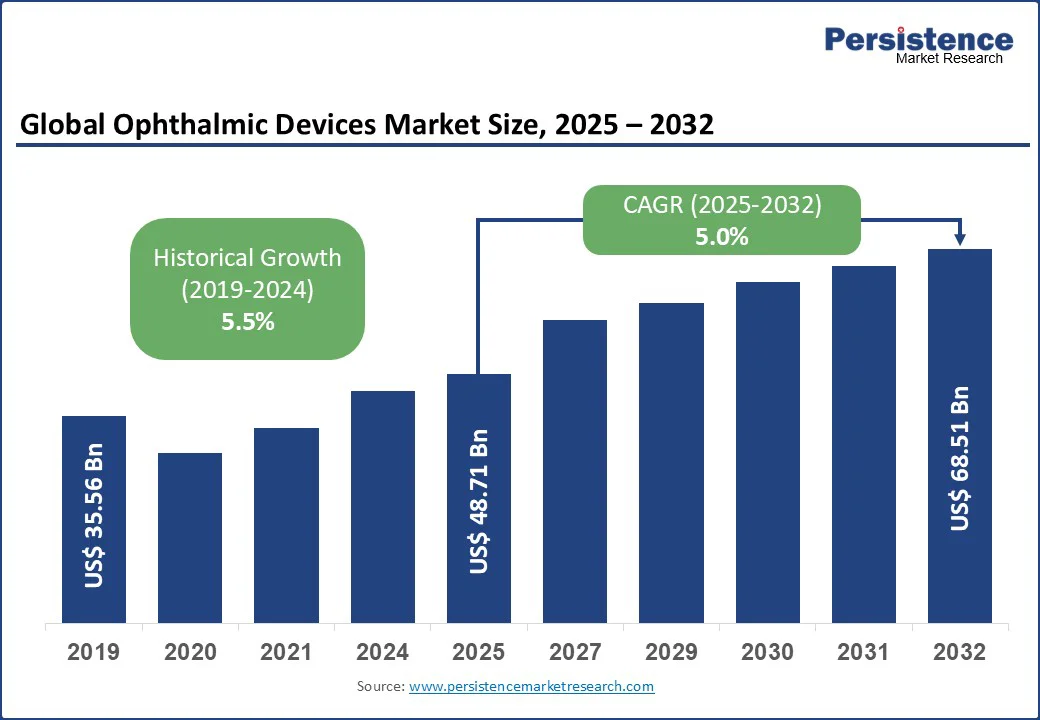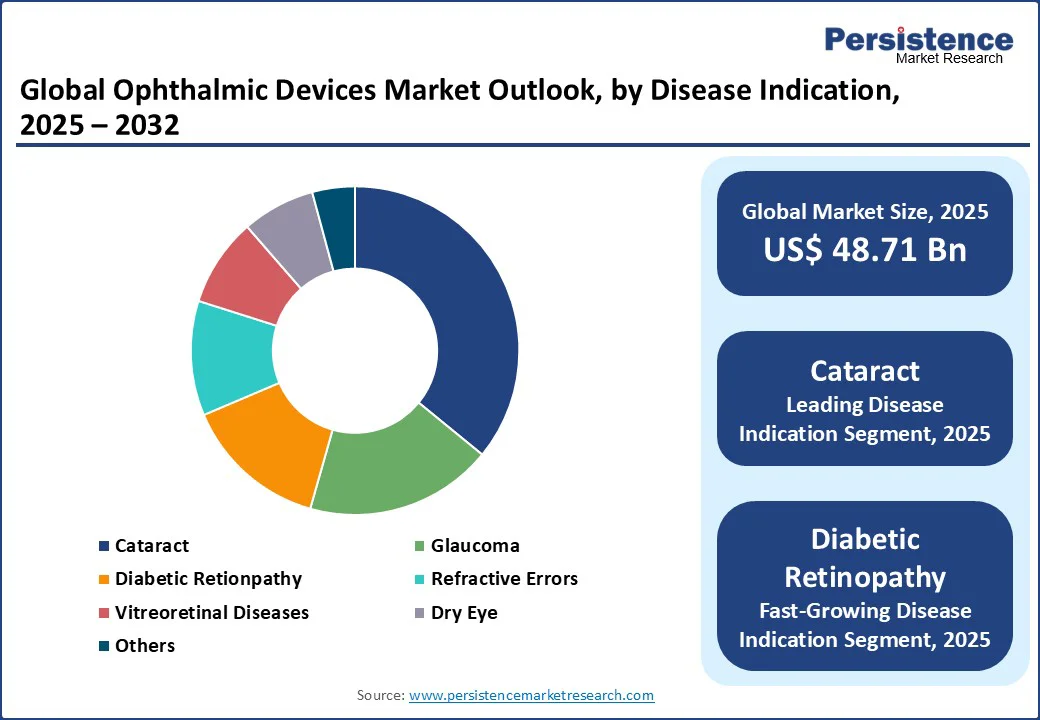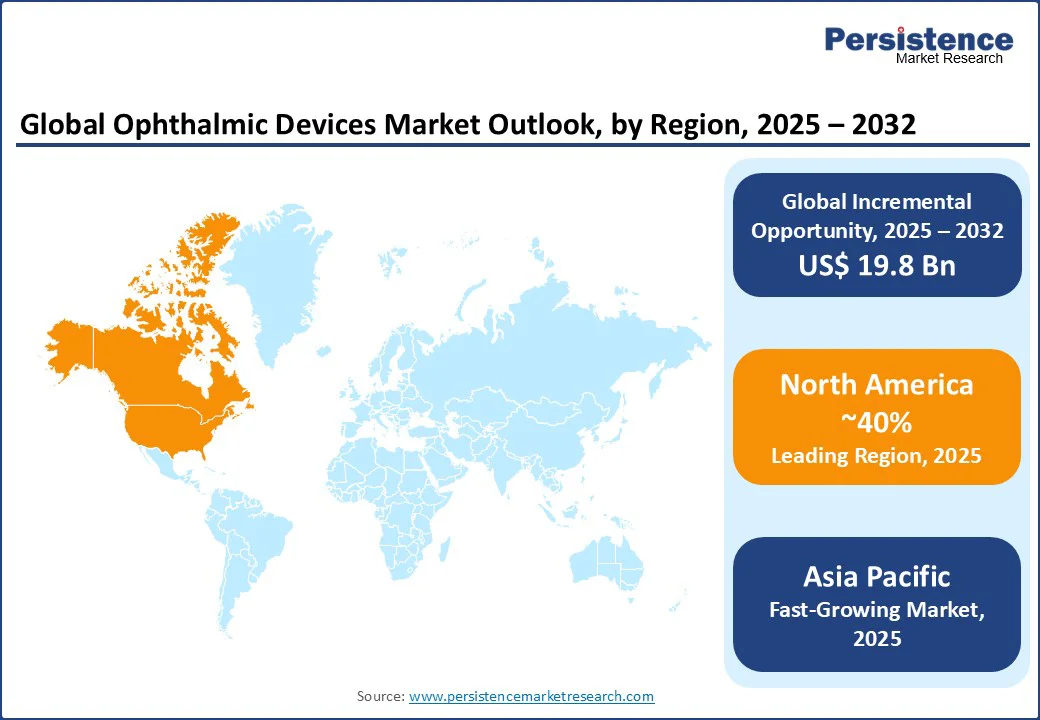ID: PMRREP3188| 173 Pages | 16 Sep 2025 | Format: PDF, Excel, PPT* | Healthcare

The global ophthalmic devices market size is likely to be valued at US$ 48.71 Bn in 2025, and is estimated to reach US$ 68.51 Bn by 2032, growing at a CAGR of 5.0% during the forecast period 2025 - 2032 due to the increasing presence of smart contact lenses, promising progress in robot-assisted eye surgeries, and the growing adoption of automated phacoemulsification systems that minimize the long wait for cataract surgery.
Key Industry Highlights:

| Global Market Attribute | Key Insights |
|---|---|
| Ophthalmic Devices Market Size (2025E) | US$ 48.71 Bn |
| Market Value Forecast (2032F) | US$ 68.51 Bn |
| Projected Growth (CAGR 2025 to 2032) | 5.0% |
| Historical Market Growth (CAGR 2019 to 2024) | 5.5% |
The accelerating global burden of age-related eye disorders accounts as the critical driver propelling the ophthalmic devices market growth into an explosive trajectory. In its World Population Prospects 2024, the UN DESA predicts that by the 2070s, the number of people aged 65 and above will reach 2.2 billion, and around the mid-2030s, nearly 265 million people will be aged 80 and above, surpassing infants.
Furthermore, the WHO estimates that of the 2.2 billion people worldwide suffering from vision impairment or loss, most are at or above the age of 50. As a result, there is a mounting incidence of cataracts, glaucoma, diabetic retinopathy, and macular degeneration.
Since all of these conditions are preventable, the demand for sophisticated ophthalmic surgical and diagnostic tools, ranging from AI-enhanced optical coherence tomography (OCT) systems to minimally invasive femtosecond lasers, which collectively improve diagnostic accuracy and surgical outcomes, is increasing speedily.
For example, femtosecond laser-assisted cataract surgery has been shown to reduce complication rates by up to 30%, boosting patient safety and recovery times, a game-changer for ophthalmologists aiming to expand high-precision care efficiently. Besides this, increasing diabetes prevalence, affecting over 537 million adults globally, as per the International Diabetes Federation (IDF), will likely amplify demand for retinal imaging and vitrectomy equipment to manage diabetic retinopathy even more.
One of the factors responsible for the limited expansion of the ophthalmic devices market is the uneven adoption of advanced ophthalmic technologies due to disparities in healthcare infrastructure and skilled workforce availability, particularly in emerging and underdeveloped regions.
While cutting-edge diagnostics and surgical devices such as femtosecond lasers offer transformative clinical benefits, their deployment is often limited by a lack of trained ophthalmologists and technicians who can operate these sophisticated instruments effectively.
For example, despite India’s vast market potential, there remain large swathes of rural areas where eye care access is restricted due to a shortage of specialists and inadequate training facilities.
Furthermore, the steep learning curve and maintenance requirements of complex ocular equipment deter smaller clinics from deploying them, creating a technological divide that restrains market growth and delays the global standardization of eye care. This gap between innovation and on-the-ground capability has ultimately slowed down the diffusion of new-age ophthalmic devices across key emerging markets.
The ophthalmic devices market is getting stimulated by the rapid advancement and integration of artificial intelligence (AI), machine learning (ML), and tele-ophthalmology into ophthalmic diagnostics and treatment. These cutting-edge technologies are revolutionizing early detection and personalized management of ocular diseases by enabling precise, automated image analysis, cloud-based patient monitoring, and remote consultation services.
For instance, a new review published in Pediatric Investigation in June 2025 explored how AI, ML, and deep learning can revolutionize early myopia care by detecting the condition from retinal images, identifying individual risk factors such as genetics and lifestyle, and predicting disease progression to aid preventive treatment strategies.
Furthermore, AI-driven platforms such as RetinAI Discovery leverage deep learning algorithms to analyze retinal images with remarkable accuracy, accelerating diagnosis of diabetic retinopathy and age-related macular degeneration (AMD) while reducing clinician workload.
At the same time, tele-ophthalmology has expanded access to eye care in remote and underserved regions, considerably increasing screening rates and early intervention, which in turn are expected to stoke the demand for advanced diagnostic devices and remote-capable ophthalmic equipment.
Among diseases, cataract is anticipated to lead the market with a revenue share of nearly 36% in 2025. This dominance is attributable to the surging prevalence of age-related cataract. The Global Burden of Disease Study 2021 found that from 1991 to 2021, the global years lived with disabilities (YLDs) due to cataracts rose by 91.8%, from 3.42 million to 6.55 million.
Innovations such as femtosecond laser-assisted cataract surgery have revolutionized treatment precision and patient outcomes, reducing recovery time and surgical risks significantly. This segment is also set to make notable gains from the growing geriatric populations, especially in China, Japan, the U.S., and the European Union (EU), where expanding healthcare infrastructure and government initiatives aim to reduce cataract-related blindness through accessible surgical solutions.
On the other hand, the segment slated to display the highest CAGR of about 7.0% through 2032 is diabetic retinopathy, essentially because of the rise in global diabetes epidemic impacting over 537 million adults, according to the IDF. The factor favouring the growth of this segment is the increasing adoption of advanced retinal imaging devices, AI-integrated diagnostic platforms, and therapeutics targeting early detection and intervention to prevent vision loss.
Notably, AI-based retinal screening tools such as the FDA-approved IDx-DR have elevated the diagnostic precision of diabetes retinopathy in primary care settings, enhancing reach and efficiency. Furthermore, rising awareness campaigns and tele-ophthalmology programs in underserved regions are broadening patient access, propelling the demand for diagnostic fundus cameras, OCT systems, and vitreoretinal surgical devices.
Vision care devices are expected to account for roughly 62% of the revenue share in the device type category in 2025, authoritatively leading the ophthalmic devices market. The enviable position of this segment is a result of the massive demand for ocular corrective solutions such as spectacles and contact lenses, getting even more fuelled by the rising prevalence of refractive errors and myopia.
Projected to affect over half the global population by 2050, the high incidence of these conditions has produced an urgent need for advanced vision correction solutions. Consumer awareness, fashion trends in eyewear, and technological advancements such as blue light filtering and smart lenses are also contributing to the growth of the vision care segment.
Contrastingly, ophthalmic diagnostic devices are anticipated to exhibit approximately 6.5% CAGR through 2032, the highest in the lot, driven by technological innovations and an increasingly critical need for early detection of eye disorders such as diabetic retinopathy and glaucoma.
Advances in optical coherence tomography, fundus imaging, and AI-powered diagnostic platforms are improving diagnostic accuracy and operational efficiency, enabling ophthalmologists to identify and treat eye diseases earlier and more effectively.
For example, AI-integrated OCT devices now enable automated retinal layer segmentation and pathology detection with over 90% accuracy, significantly improving clinical decision-making and patient management. Furthermore, the rising adoption of tele-ophthalmology and portable diagnostic tools in emerging markets is expanding access to eye care, stimulating the demand for advanced ophthalmic diagnostic equipment globally.

North America is set to command approximately 40% of the ophthalmic devices market share in 2025 on account of the robust healthcare infrastructure, supportive reimbursement systems, and widespread awareness about ocular disorders and age-related eye diseases across the U.S. and Canada.
The regional market also benefits from the rapid adoption of cutting-edge medical technologies, including AI-enabled diagnostics, femtosecond lasers, and minimally invasive glaucoma surgery devices. For example, the U.S. leads the market here, aided by an increasing geriatric population and a rising incidence of diabetic retinopathy and glaucoma.
Insurance models and regulatory frameworks are also being modified to favor patient safety and encourage innovation, enabling faster introduction of new ophthalmic devices into the market.
Asia Pacific, expected to be the fastest growing regional market through 2025 - 2032 with an estimated CAGR over 7.0%, is propelled by a high prevalence of preventable eye diseases and vision impairment affecting millions, a substantial diabetic population, and rapidly aging demographics.
Countries such as China, India, and Japan are spearheading the demand for cutting-edge ophthalmic devices due to increased government interventions in meeting cataract surgery backlogs and promoting diabetic retinopathy screening programs.
Innovative models such as Aravind Eye Care’s telemedicine network in India are revolutionizing access to such treatments and technologies in rural areas, where 60% of screenings occur in community health camps. The rise of local manufacturing hubs in China and South Korea have reduced import dependency and pushed the adoption of cost-effective ophthalmic devices, further accelerating market expansion.
Europe, characterized by mature healthcare systems with universal health coverage prioritizing early diagnosis and treatment of age-related ophthalmic diseases such as AMD and glaucoma, offers excellent opportunities for market players.
Stakeholders in the region are also known to show strong adoption of advanced diagnostic platforms such as high-resolution OCT and scanning laser ophthalmoscopes, especially in Germany, France, and the U.K. Dedicated government-supported screening programs and regulatory support for innovative medical devices, including streamlined CE marking processes in the European Union (EU), are likely to aid regional market penetration.
The gradual transition to AI-powered diagnostics among healthcare facilities and professionals in Europe signals a movement toward precision ophthalmology with an aim to enhance patient outcomes.

A confluence of factors revolving around relentless innovation, strategic acquisitions, and intricate collaborations is governing the dynamics of the competitive landscape of the global ophthalmic devices market.
At the forefront is the integration of artificial intelligence and machine learning into diagnostic platforms and surgical tools by key players such as Alcon Vision and Johnson & Johnson, facilitating early intervention in preventable diseases such as glaucoma and diabetic retinopathy. Several large players are also increasingly investing in precision surgical systems such as femtosecond lasers that reduce complications and recovery times.
On the other hand, industry leaders are implementing mergers & acquisitions (M&A) strategies in a bid to diversify their portfolios and amplify geographic reach. Moreover, the rise of cloud-based data analytics and tele-ophthalmology is envisaged to sufficiently meet the growing demand for remote patient monitoring, creating new service-based revenue streams and fostering value-based care models.
The global ophthalmic devices market is projected to reach US$ 48.71 billion in 2025.
The increasing prevalence of age-related eye diseases amid a rapidly aging population globally drives the market.
The ophthalmic devices market is poised to witness a CAGR of 5.0% from 2025 to 2032.
The advancement and integration of artificial intelligence (AI), machine learning (ML), and tele-ophthalmology into ophthalmic diagnostics and treatment are key market opportunities.
Alcon Vision LLC, Johnson & Johnson Vision Care, Inc., and Essilor International S.A.are some leading players.
| Report Attribute | Details |
|---|---|
| Historical Data/Actuals | 2019 - 2024 |
| Forecast Period | 2025 - 2032 |
| Market Analysis | Value: US$ Bn/Mn, Volume: As Applicable |
| Geographical Coverage |
|
| Segmental Coverage |
|
| Competitive Analysis |
|
| Report Highlights |
|
By Device Type
By Disease Indication
By End-User
By Region
Delivery Timelines
For more information on this report and its delivery timelines please get in touch with our sales team.
About Author